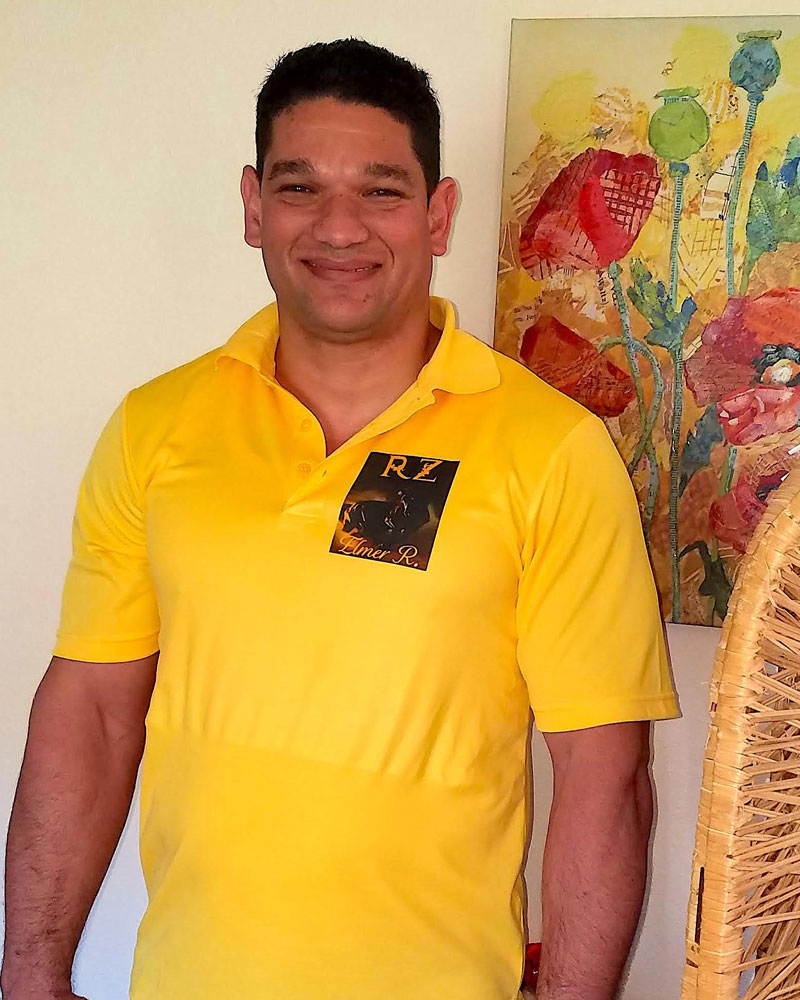Elmer from Cuba
“I was born in a small town in Cuba and owned two small businesses. Due to threats of prison and extreme political oppression, my wife and I decided I should try to immigrate to the U.S. to find a more secure life for our family.”
“Besides experiencing persecution by the police and demands for payments, my family also faced serious food shortages in Cuba. People wait in a three-hour line to buy a chicken, and when they get to the counter, there is no chicken. My family bought only the basics; there was no way to get ahead. I was threatened with prison various times, and I knew my family could not survive if I was in prison. Many people were imprisoned for having their own business, a recently permitted situation in Cuba, and supposedly not following government regulations.”
“The oppression became too much. A friend and I decided to leave Cuba. It was a hard decision to leave my wife and two small children, but there was no security for them there.”
“I did not pay a “coyote” to take me from Cuba to the U.S.-Mexican border, as many people do, because I did not have the money. In April 2019, I got a visa to visit Nicaragua, with which Cuba has good relations, and I bought a plane ticket to Managua. Upon landing, I paid the equivalent of about $130 US dollars to a taxi driver to drive me to the Honduras border. In Honduras, I presented my Cuban documents and bought a bus ticket to Guatemala. In Guatemala, I bought a bus ticket across the country to the western border with Mexico. “
“I walked across the shallow Suchiate River with another Cuban guy. We grabbed a combi van with other migrants who had also walked across the river. The Mexican police stopped the combi van, made all of us get out, then demanded money. While they were talking to others, my Cuban friend and I took off running. We walked all night, over 30 kilometers to the closest border town, Tapachula, in the state of Chiapas, Mexico.”
“Cubans and many other immigrants were in Tapachula and Mexican authorities were deporting Cubans back to Cuba. So, I paid for a hotel room as a regular tourist for a week to check out the best ways to get to the US border. I walked by a perfume store and, attracted by the pleasant scents, I went inside. A Cuban had been working there for 3 months and we started talking. The woman who owned the perfume store gave me a map showing me the best route to travel north to avoid Mexican immigration officials.”
“With the Cuban guy I had been traveling with, we departed Tapachula, avoiding buses full of immigrants traveling north, since we were told they were constantly extorted by Mexican police. Instead, we paid different taxis to take us through multiple cities to Mexico City. We stopped in various towns, sleeping in orchards on piles of leaves under mango trees, our meals consisting of mangos. That was our bed and breakfast. After three days, we arrived in Mexico City. “
“We looked for the closest US-Mexico border to cross and decided to take a bus to Nuevo Laredo, across from El Paso, Texas. We were told not to speak Spanish if any group stopped the bus. True to that warning, some heavily armed men stopped the bus close to Nuevo Laredo and we had to get off. We remained silent while they told us they were “Zetas”, and we had to give them our money; we knew the “Zetas” to be the major drug cartel in that area. I wasn’t too afraid, having seen armed men before. While the narcos were busy blackmailing others in Spanish, my friend and I escaped around the back of the bus and ran as fast as we could.”
“We walked to Nuevo Laredo where we found churches giving shelter to immigrants. With the little money we had left, my friend and I rented rooms in a house and looked for work in Nuevo Laredo. We worked for 1,000 Mexican pesos per week (about $50 US) in a Casa de Cambio (money exchange business). The guy who owned the business wanted me to stay and work there. We also met Cubans who had friends in El Paso. After a month of traveling from Cuba, we bought bus tickets to El Paso, like tourists or cross-border workers do. When we got off the bus, some officials took us to a police station. The police there felt sympathy for us and let us go free. They did not ask for any money either, although a man at the US border crossing charged us $100 dollars. The crossing day was May 7, 2019. We then went directly to the U.S. border control officials and asked for asylum.”
“The US border patrol took us to a holding cell that was very cold–they call it “La Hielera,” the freezer. The temperature was three degrees below zero Centigrade (26° F). After a few days there, I was sent to a Texas immigration detention center. I had not bathed in seven days, so was able at least to take a shower and it was warmer inside. After a few days, on May 17, 2019, they flew me, in handcuffs and shackles, with others on an ICE plane to the middle of Washington State, and then by bus to the Tacoma ICE Detention Center.”
“I was at the Tacoma Detention Center for 5 ½ months, 6 months total in detention including the time in Texas. I was released in Tacoma in October 2019. I had no sponsor in the U.S. so the ICE officer told me to go to the RV parked in the street outside the detention center, operated by an organization that would help me. The AIDNW volunteers there welcomed me, gave me new clothes, and took me to their Hospitality House. AIDNW staff there made me feel welcome.”
“I was very happy to finally be free after six months in detention and over a month traveling from Cuba. Staying at the AIDNW Hospitality House was super good. The AIDNW manager, Deborah, was a huge help to me. She connected me with World Relief, who in turn found me an apartment and provided food and English language learning support.”
“I found a job working for a building contractor–12-hour days for $100/ week. I knew carpentry because of my business in Cuba. Of course, he took advantage of my need to work, but I learned how to lay flooring and other building trade jobs. I like math, so construction measurements and carpentry were easy for me to learn. I met a colleague of my employer who is a home designer and had been in the US for 20 years. We talked about partnering in a design-build company. I was used to working for myself in my businesses in Cuba, so I had confidence I could have my own company here.”
“In 2021, we registered a company and began taking on remodeling projects, mainly kitchens. My company is RZ Pro-Construction, LLC, and we are general contractors in Kent, WA. My biggest challenge now is finding skilled carpenters who want to work. I offered $35 dollars per hour. I have hired some immigrants who have work papers, but not all are suited to this type of precise carpentry work.”
“I began the process of bringing my wife and two daughters here. In September 2022, they came across the southern border, and we are now living together, navigating their asylum process. We are so happy to be reunited! My contracting business is growing. There is an abundance of work here in the building and remodeling business and I am willing to pay market rate for good employees. I think it will take about two years for me to get my residency and citizenship, which is my longer-term goal.”




